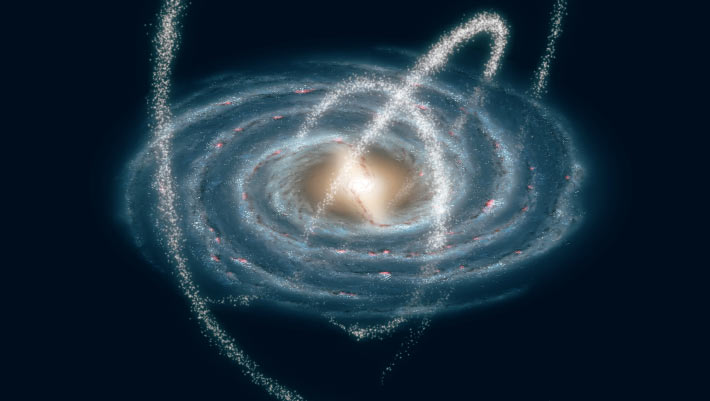Star Streams: Remains of Eaten Galaxies
The heaviest is the strongest
In a sense, in space work the same laws as in nature, the strong devour the weak. How object is strong, determined by its gravity. The bigger and heavier the object, the greater its gravitational force by which it pulls smaller objects. Supernova devour small stars, large galaxies devour their smaller neighbors, black holes devour everything around, including each other.

[image source]
These processes can take millions and billions of years, and of course eaten objects don't disappear without a trace. Even if you consider the fact, that black holes absorb even the photons, which in fact do not have a mass. In the case of galaxies, we can observe clear evidence of their victory or defeat in the struggle for evolutionary growth.
Skeletons of Galaxies
We used to represent a single galaxy as a disk of billions of stars that move in one plane around a common center. That's how the Milky Way looks in the usual sense:

The Milky Way, the view from the top, or bottom... Spiral galaxy with a length of 100,000 light years. [image source]
However, if we step back a bit and look a little closer, we can detect a strange halo. Giant circles with a length of several tens of thousands of light years, which are moving around the same galactic center, but in a different plane relative to the galaxy:

The plane of the stellar stream depends on the angle of "meeting" of two galaxies. [image source]
Such structures are called star streams. Traces of a cosmic feast, consisting of stars, cosmic dust and gas. The remains of dwarf galaxies that have been absorbed by their larger neighbors, and now are forced to rotate around their killers billions of years.
Earlier in the area of our galaxy was discovered about two dozen star streams of various mass and density. But recently, within the Dark Energy Survey project, scientists discovered 11 more star streams, and apparently this number will continue to grow.
 The largest and most massive stellar stream near our galaxy is the Magellanic Stream, its mass is only 1% of the stellar mass of the Milky Way, but its length is 1 million light years. [image source]
The largest and most massive stellar stream near our galaxy is the Magellanic Stream, its mass is only 1% of the stellar mass of the Milky Way, but its length is 1 million light years. [image source]Stellar streams allow modern astronomers to trace the history of the evolution of galaxies, their growth and structure formation. In fact, this is a snapshot of how this or that galaxy grew, formed from the merger and absorption of individual small galaxies.
Thus, our home galaxy over 13 billion years of its existence, has consumed at least three dozen nearby galaxies and star clusters. And we are very fortunate that we are almost the biggest in this sandbox…
Will Another Galaxy eat the Milky Way?
We are massive enough within the boundaries of our galactic group, not to be eaten.

There are three large galaxies in our sector, in ascending order: Triangulum Galaxy (M33), Milky Way and Andromeda Galaxy. [image source]
Among the approximately 50 neighbors, we have only one serious competitor, our older sister- the Andromeda Galaxy, which is 2.5 times bigger than Milky Way. Someday we will meet.
To be precise, after 4 billion years the Milky Way and Andromeda will converge in a gravitational dance, which will lead to a merger, not an absorption. This process will take billions of years and as a result, the formed monster will eat the remaining small galaxies, forming one giant super galaxy.

First Row, Left: Present day.
First Row, Right: In 2 billion years the disk of the approaching Andromeda galaxy is noticeably larger.
Second Row, Left: In 3.75 billion years Andromeda fills the field of view.
Second Row, Right: In 3.85 billion years the sky is ablaze with new star formation.
Third Row, Left: In 3.9 billion years, star formation continues.
Third Row, Right: In 4 billion years Andromeda is tidally stretched and the Milky Way becomes warped.
Fourth Row, Left: In 5.1 billion years the cores of the Milky Way and Andromeda appear as a pair of bright lobes.
Fourth Row, Right: In 7 billion years the merged galaxies form a huge elliptical galaxy, its bright core dominating the nighttime sky. [source]
sources: STELLAR STREAMS: DETECTION METHODS AND EXAMPLES, Milky Way Collide NASA, Dark Energy Survey, Naked Science, How do galaxies die.

Brilliant post @natord. enough said
Thank you, always nice to hear kind words :)
Maan, space is really cool. I wish my undergraduate course was more space related but I studied Geology :(
Well, you have a perfect base to explore the space independently :)
Nice illustration sequence! Are the chances of the planet surviving this merger high? Or even getting to that point, really... If we manage to escape our own extinction and somehow we're still there, I imagine the light pollution will be so great nobody will notice the beauty at 3.75 b year mark. Wow that's such a long stretch of time....
At the beginning of the merging galaxies, the brightness of our sun will increase by 67%. This will lead to the fact that our planet will turn from a blossoming oasis into a huge greenhouse, as Venus. All life on the planet's surface will die even when brightness increase by 20%, organisms in the oceans can hold out a little long. So, after 4 billion years the Earth will be lifeless.
It is quite possible that we will see for this merger from the new home, somewhere on the edge of the universe, if humanity will go on the right path of development.
I learnt a lot about our Milky Way and now I will have to try and build this info into my stories. I love it when I am offered the opportunity to learn something new, without it being so complex that my eyes glaze.
PS: As a chocaholic, just had to mention, I used to love my Milky Way chocs, but they disappeared from the shelves. I hate it when the companies do that.
I am very pleased to hear that you've broadened your knowledge and it was easy.
By the way, in my country these chocs are on sale.
interesting post
Thank you.
sir new to steemit please follow and upvote my posts
Fantastic article, dear friend
Excellent article. I did not know anything about the Milky Way. Very educational your post. regards